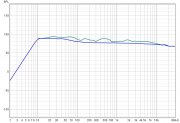Did amp gain matching to the drivers today within the MiniDsp plugin to approximate a "Harman house curve" I downloaded into REW. Going to give this particular house curve a shot.
Boosted the 700 WOPL output by 10 dB for the subs.
Left the 400 WOPL output unchanged for the woofers.
Reduced the 400 WOPL output by 7 dB for the midrange.
Reduced the PL300S2 output by 5 dB for the tweeters.
Been testing different gain profiles all day. I'm surprised by how much small a gain structure change affects the sound.
Next up is generating the EQ filters and plugging them in to closely match the house curve, then time alignment of the drivers.
Boosted the 700 WOPL output by 10 dB for the subs.
Left the 400 WOPL output unchanged for the woofers.
Reduced the 400 WOPL output by 7 dB for the midrange.
Reduced the PL300S2 output by 5 dB for the tweeters.
Been testing different gain profiles all day. I'm surprised by how much small a gain structure change affects the sound.
Next up is generating the EQ filters and plugging them in to closely match the house curve, then time alignment of the drivers.




